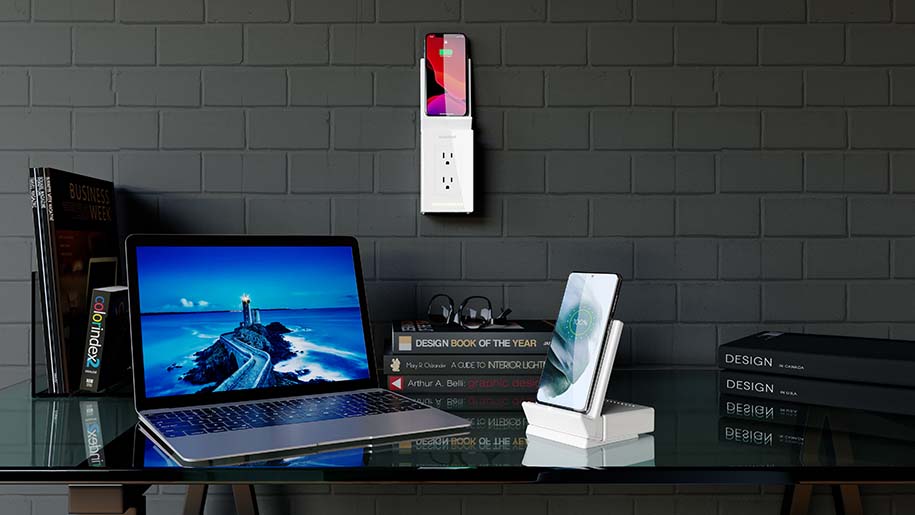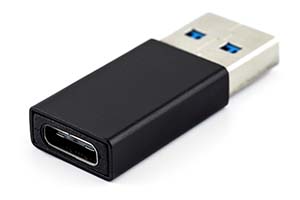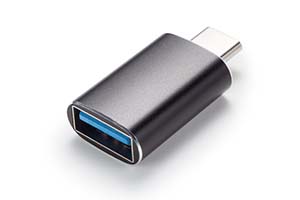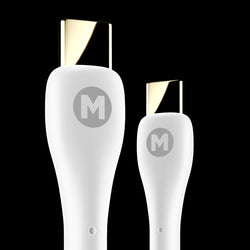
Keeping Up with Cables and Connection Types
The ever-evolving world of technology has seen the way we charge devices change at a rapid pace … from the days of chunky AC/DC power supplies with a long gangly cable to the wireless capability that allows you to charge your phone sans wires. Remaining powered up has become easier than ever.
There are times though when the charging world moves quicker than the hardware world. Your laptops, tablets and phones all employ cutting-edge tech but do not always utilize the best in charging developments.
How a USB-C to USB-A adaptor keeps you connected
This, in part, is why tools such as the USB-C to USB-A adaptor fills a gap in the market. Fast charging cables – ones equipped with a USB-C connection – require an adaptor so they can be used to power our USB-A devices.
Most device power cables come with a standard USB-A connector for you to connect to the plug that attaches to the outlet. It is what is at the other end of the cable that transfers the juice to your tech, and many these days have a USB-C ready to be connected. Sometimes though, that isn’t what you need.
Connection adaptors will mean you can reduce the number of cables you have in your home. Instead of keeping a drawer full of various cables with different connector types for all your devices, you can have one cable and use the adaptors to make it compatible with whichever device you need. Most cables and connection types nowadays will also allow bi-directional use – so, you can use the same cable to transfer power into your device and also transfer files out of it and onto another device.
What is a USB-C to USB-A adaptor and what are they used for?
Put simply, these adaptors allow a cable with a USB-C connection to be attached making it fully compatible with a USB-A device. They allow a consistent charge, ensuring you can keep connected and powered up all the time.
Common devices that may require an adaptor of this kind to charge and transfer data include cameras, USB hubs, and flash drives. For example, an Apple Mac that has a Thunderbolt 3 or USB-C port will require an adaptor to connect to a USB-A charging device.
What is a USB-C female to USB-A male adaptor?

How is a USB-C male to USB-A female adaptor different to the above?

How could you benefit from a USB-C to USB-A adaptor?
As touched upon above, cables with USB-C connectors are steadily becoming the norm. With their fast-charge capabilities and data transfers, they are gradually being accepted by the manufacturers of tech as the way forward. This has meant that many tech giants are having to reassess how they build their devices to match the changes.
So, as USB-C becomes more popular for our devices, we’re more likely to have USB-C cables around to use with them. However, many units still retain USB-A ports meaning that, to make use of them, your new cables will need a USB-C to USB-A adaptor. The benefit of a USB-C to USB-A adaptor is that it lets you use a USB-C cable for your devices that require USB-A, meaning you can streamline your charging tech.
What is USB-A connection?

Formed of a rectangular shaped connector, every USB-A may look the same upon first glance, but each variation has subtle differences. For example, the earlier versions of USB-A (compatible with 1.1 and 2.0 USB cables) have 4 pins with which to transfer data and power whereas the more recent 3.0 contain 8 allowing for faster processes.
Whilst USB-C is newer, USB-A looks set to be around for a long time yet, not least because the connectors are on almost every charging plug on the market.
What is USB-C connection?

Much like USB-A, there have been evolutions in its development. The variations, as seen on the USB-A (3.0, 3.1 etc.) have allowed for quicker speeds in data transfer and much faster charging of portable devices. Whilst sending data back and forth, a USB-C can provide up to 100 watts of power.
Significantly smaller than USB-A, the C-type is often confused with other smaller charger types. You will notice the USB-C is embraced by manufacturers of mobile phones, handheld consoles and laptops.
A common spec favored by users is the ability to use a USB-C with reverse plug orientation, meaning that no matter which way round the cable is, you can still plug it in. Type C USB has also been lauded due to its ability to offer bi-directional power. This means you can charge your phone via your laptop, and the other way around.
USB speeds
The variations of the original 1996 invented device have seen exceptional progress in data transfer and charging speeds thanks to the capabilities of the cables. Where they could initially transfer data at just 12Mbps, an evolution then saw it progress to an impressive 480Mbps. The version 3.0 then saw speeds reach exceptionally fast levels hitting a staggering 5,000Mbps. In 2013, a further innovation saw the 3.1 released which was double the capability of its predecessor, clocking 10,000Mbps.
Alternatives to USB-C to USB-A
Whilst USB-C and USB-A are probably the most used, there are many devices out there that require an alternative method of charging. Some, like Apple devices, requiring a Lightning connector, others charging via micro-USB.
This has led to a variety of cables being needed to keep you connected – luckily though, alternative adaptors remove that issue, meaning that one cable or powerbank will be all you need to charge any device.
Adaptor tips for Lightning and micro-USB
At MAGFAST, we have developed adaptor tips to work with any device requiring a Lightning, USB-C or micro-USB connection, providing a smooth connection and fast charge. Simply get your cable, connect the relevant tip and plug into your device. It really is that simple!
MAGFAST mini USB-C cable
Sometimes, you don’t have the cable but do have multiple devices; luckily our MAGFAST USB-C mini cable means you can either connect your tablet or laptop to your phone and enjoy an instant power share. Alternatively, enjoy the superpower storage capabilities of any MAGFAST product by connecting the mini-cable to your device and plugging it into one of our variety of multi-use chargers.
MAGFAST Lightning mini-cable
Just like our USB-C variation, this mini cable means that should your iPhone, iPad or Mac need a boost when you are short on cables, you can simply connect to a MAGFAST power bank and transfer the abundance of power it has stored up and reboot your device!
Understanding USB variations
So far, you may have read about USB-A, USB-C and 3.0 or 3.1 but when it comes to knowing what you need, the combination of numbers and letters can be confusing. There are countless Google searches asking if USB-A is the same as USB 3.0 or whether USB-C is actually USB 3.1. So, to help make things a little clearer, we thought it best to clarify so you get the best charging options for your devices. The simplest thing to remember is that the letter following USB refers to the connector type. A number after USB refers to the cable type.
USB-A
The USB-A connector can work with the USB 1.0, 1.1, 2.0, 3.1 and 3.1 cable, the higher number associated with the USB cable showing a more recent incarnation of the technology. You will know if you are using a USB 3.0 on your type A connector by seeing blue inside the metal casing. 2.0 on the other hand is white inside.
USB-C
A USB-C connector can do exactly the same as USB-A but can accept all cable types. However, it is only produced in USB version 3.1 and above. As touched upon earlier, it can also never plug in the wrong way.
Our Charging Revolution
At MAGFAST, we are revolutionizing the way the world thinks about charging devices. Our unique range of premium power banks and chargers allows you to reman connected for longer.
The ‘snap-to-charge’ capability allows you to connect together different members of the MAGFAST family so you can share the charge with friends or power up multiple devices at once, the Qi wireless charging technology allowing you to keep powered up when you don’t have any cables!
Want to know more and become part of the revolution? Join us for our free demo and see how MAGFAST is changing the way you think about charging. You may even win $1,000 worth of incredible tech products.
- Keeping Up with Cables and Connection Types
- How a USB-C to USB-A adaptor keeps you connected
- What is a USB-C to USB-A adaptor and what are they used for?
- How could you benefit from a USB-C to USB-A adaptor?
- What is USB-A connection?
- What is USB-C connection?
- Alternatives to USB-C to USB-A
- Understanding USB variations
- Our Charging Revolution
America's highest-rated smart phone cable ...



